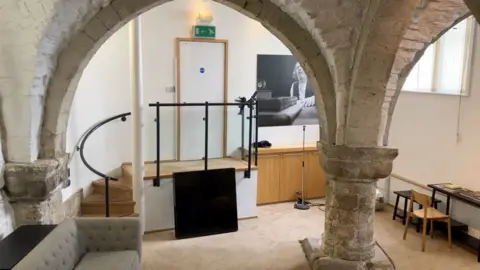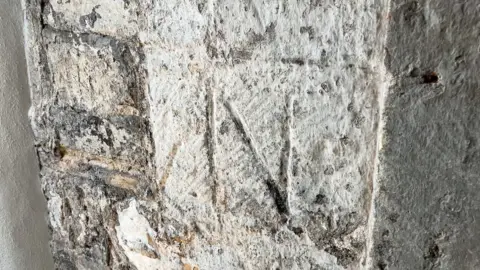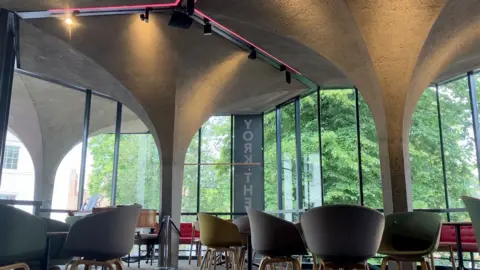The medieval hospital hidden in a theatre
 Kit Taylor/BBC
Kit Taylor/BBCWhen you go to the theatre, you imagine being surrounded by red velvet curtains and golden gilded stages. What you might not expect are grand medieval pillars and roman walls, steeped in the history of York.
When a sinkhole suddenly opened on St Leonard's Place in May, people were astounded by the medieval ruins that lay under the busy city centre road.
But they are a small part of the vast 888-year-old St Leonard's Hospital which has been mostly hidden underground, with a floorplan stretching from the Museum Gardens to York Minster.
And tucked away in unassuming corners of York Theatre Royal are perfectly preserved examples of tall medieval pillars and original groin vaulting.
John Soper, tour guide at the theatre, said: "In a way we've got to thank Henry VIII and the dissolution of the monasteries in 1540, because not only does he knock down all the abbeys, he knocks down the hospitals.
"In the 18th Century, [Elizabeth] Keregan who starts to build her theatre looks about for a place to buy, and there is a chunk of the hospital left standing.
"She starts to build her theatre on this site, on top of the old hospital and around it.
"This is why we've got so much of it in the theatre itself.
"It's incredible to think that you can just pop in and see so much history."
 Kit Taylor/BBC
Kit Taylor/BBCAs well as ruins of the medieval hospital, there is also a Tudor fireplace backstage, and a Roman well directly underneath the stage.
Opposite the box office are the remains of an original hospital gate, where the builder has carved their initials.
 Kit Taylor/BBC
Kit Taylor/BBCMuch of the new theatre reflects its history too.
When the cafe area was built in 1967, architect Patrick Gwynne designed the shuttered concrete pillars to reflect the medieval ones.
The pattern on the flooring also mirrors the original layout of the hospital.
 Kit Taylor/BBC
Kit Taylor/BBCSt Leonard's Hospital had little in common with a modern facility, with Mr Soper describing it as "more like a stopping-off point".
"If you were on a pilgrimage and you were going up to the Holy Island of Lindisfarne, or you might be coming to see the newly built York Minster, you would have appeared at the gateway to this hospital which is in the Museum Gardens.
"Try and imagine it as a little village sat inside the city of York.
"There would be cattle and sheep, and they would be growing hops for beer.
"They had vineyards in there, they would be making their own wine.
"If you were considered to be very old, something like 47, if you paid a few coins to the monks then you would go and live in there and they would look after you."
 Kit Taylor/BBC
Kit Taylor/BBCMr Soper wants to encourage more people to re-engage with their local history.
"What I would say to you is just keep your eyes open, use your imagination, and rediscover your city of York," he said.
Listen to highlights from North Yorkshire on BBC Sounds, catch up with the latest episode of Look North or tell us a story you think we should be covering here.
